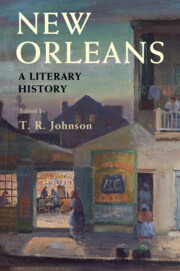Book contents
- New Orleans
- New Orleans
- Copyright page
- Dedication
- Contents
- Contributors
- Preface
- Acknowledgments
- Chapter 1 Swamp City
- Chapter 2 Mixed Motives
- Chapter 3 “As I Have Seen and Known It”
- Chapter 4 What New Orleans Meant to Walt Whitman
- Chapter 5 Coloring Sex, Love, and Desire in Creole New Orleans’s Long Nineteenth Century
- Chapter 6 The White Creole Tradition
- Chapter 7 The Civil War’s Literary Aftershocks
- Chapter 8 Illusion and Disillusion
- Chapter 9 Local Color, Social Problems, and the Living Dead in the Late-Nineteenth-Century Short Fiction of Alice Dunbar Nelson
- Chapter 10 Kate Chopin, Edna Pontellier, and the Predicament of the Intellectual Woman in New Orleans
- Chapter 11 Converging Americas
- Chapter 12 A Jazz Origin Myth
- Chapter 13 “Stepping Out” of the Storyville Frame
- Chapter 14 Louis Armstrong’s Autobiographical Art
- Chapter 15 New Orleans, Modernism, and The Double Dealer, 1921–1926
- Chapter 16 “Because What Else Could He Have Hoped to Find in New Orleans, If Not the Truth”
- Chapter 17 “The Place I Was Made For”
- Chapter 18 A Civil Rights–Era Novel of the American Civil War
- Chapter 19 How to Survive the Best Environments
- Chapter 20 Tom Dent and the Development of Black Literature in New Orleans
- Chapter 21 The Gothic Tradition in New Orleans
- Chapter 22 A Flaneur in the French Quarter and Beyond
- Chapter 23 Literary Fiction by New Orleans Women, 1961–2003
- Chapter 24 Asian American New Orleans
- Chapter 25 New Orleans Rap and Bounce
- Chapter 26 The Literature of Hurricane Katrina
- Chapter 27 Swan Song?
- Index
Chapter 27 - Swan Song?
Published online by Cambridge University Press: 23 August 2019
- New Orleans
- New Orleans
- Copyright page
- Dedication
- Contents
- Contributors
- Preface
- Acknowledgments
- Chapter 1 Swamp City
- Chapter 2 Mixed Motives
- Chapter 3 “As I Have Seen and Known It”
- Chapter 4 What New Orleans Meant to Walt Whitman
- Chapter 5 Coloring Sex, Love, and Desire in Creole New Orleans’s Long Nineteenth Century
- Chapter 6 The White Creole Tradition
- Chapter 7 The Civil War’s Literary Aftershocks
- Chapter 8 Illusion and Disillusion
- Chapter 9 Local Color, Social Problems, and the Living Dead in the Late-Nineteenth-Century Short Fiction of Alice Dunbar Nelson
- Chapter 10 Kate Chopin, Edna Pontellier, and the Predicament of the Intellectual Woman in New Orleans
- Chapter 11 Converging Americas
- Chapter 12 A Jazz Origin Myth
- Chapter 13 “Stepping Out” of the Storyville Frame
- Chapter 14 Louis Armstrong’s Autobiographical Art
- Chapter 15 New Orleans, Modernism, and The Double Dealer, 1921–1926
- Chapter 16 “Because What Else Could He Have Hoped to Find in New Orleans, If Not the Truth”
- Chapter 17 “The Place I Was Made For”
- Chapter 18 A Civil Rights–Era Novel of the American Civil War
- Chapter 19 How to Survive the Best Environments
- Chapter 20 Tom Dent and the Development of Black Literature in New Orleans
- Chapter 21 The Gothic Tradition in New Orleans
- Chapter 22 A Flaneur in the French Quarter and Beyond
- Chapter 23 Literary Fiction by New Orleans Women, 1961–2003
- Chapter 24 Asian American New Orleans
- Chapter 25 New Orleans Rap and Bounce
- Chapter 26 The Literature of Hurricane Katrina
- Chapter 27 Swan Song?
- Index
Summary
Recent research by climate scientists suggest that New Orleans, much of which is below sea level and protected from the sea only by a rapidly eroding marshland, may someday become uninhabitable. The city’s literature of the last few decades has been preoccupied with the theme of fatalism and apocalypse, and the deadly epidemics of the nineteenth century have provided rich symbolic terrain for figuring the troubles that “plague” the city and that will someday mean its end. Some recent work by women of color – notably Erna Brodber and Brenda Marie Osbey – delineates a different literary project, one appropriate to a post-apocalyptic diaspora, namely the work of remembering. Both the traditional fatalism and this emerging interest in memory will likely be central themes to watch for in the major literature associated with the New Orleans in coming decades.
Keywords
- Type
- Chapter
- Information
- New OrleansA Literary History, pp. 356 - 372Publisher: Cambridge University PressPrint publication year: 2019

